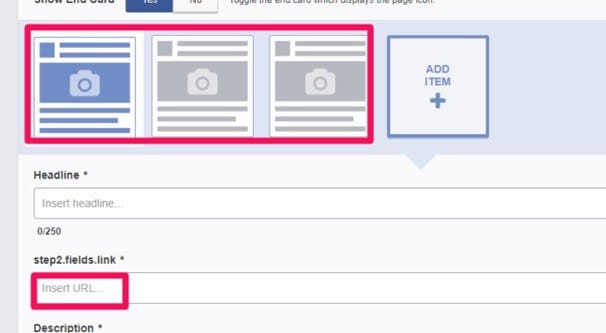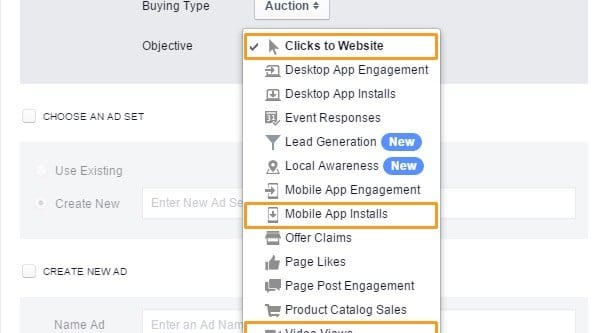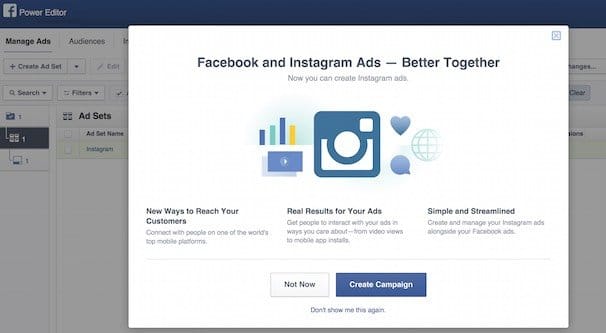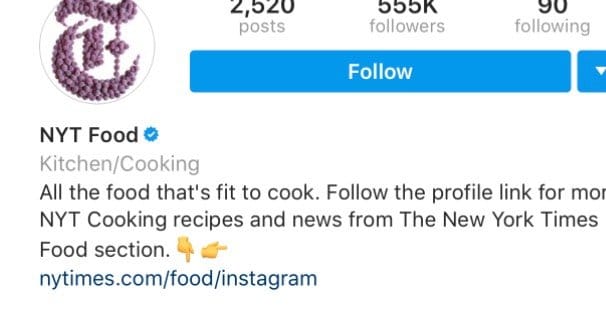 Written by ContentPowered.com
Written by ContentPowered.com
There are three ways to have a call to action on Instagram. Two of them are “soft” CTAs, in that they aren’t supported by the platform, they’re just ways to use the platform. The third is the official “hard” CTA, that is, a button integrated with the platform rather than just a link.
The Hard CTA
The hard CTA is only available on Instagram if you use ads to make it. If you use Instagram without an ad blocker, you’ve surely seen these. They look just like any other post, except in the upper right corner is a “sponsored” label, and at the bottom is a horizontal bar that contains a call to action. The bar takes up some space beneath the image, but above the engagement and caption. It has its own space, rather than sharing it with the like and reply buttons.
Up until recently – last month, in fact – this bar was white until you hovered over it or tapped on it, at which point it was blue. Now, the button changes color dynamically to match the primary color of the image you posted. This makes the bar look more like part of the image, instead of being a bright blue flag that the image was an ad.
Savvy users, of course, will immediately identify the post as an ad regardless. A more color-adjacent call to action will simply make it a little more attractive to see in a feed, and thus more likely to gain a bit of attention prior to being clicked or scrolled past.
As I mentioned up above, the hard CTA is only available in an Instagram ad. So let’s talk about ads.
Instagram Ads
Making ads on Instagram uses the Facebook ads manager, because Facebook owns the site. So don’t be surprised to see Facebook links or mentions of Facebook below.
Instagram ads come in a few different formats, each with their own perks.
- Image ads. These are basic images with the CTA button beneath them. They’re static, they’re effective, and they’re cheaper and easier to produce than pretty much any other ad on the platform.
- Video ads. Videos have more visibility and engagement than images almost always, but they’re also much harder to actually produce. Instagram video ads can be up to 60 seconds in length, and have the CTA below them.
- Carousel ads. Ever wish you could push more than one image in an ad, because you want a long horizontal image or you want several images to display your aesthetic or product? Carousel ads are for you. They’re comprised of several images in a row, with the CTA button below them.
- Stories ads. Instagram stories are essentially auto-play videos mixed with images in a collage. They’re unique in that once they have played in a user’s feed, they disappear, and they have a limited display time.
All Instagram ads have objectives you can choose for them.
The objectives are:
- Brand awareness, which is cheap, but does little more than show your brand post to as many people as possible.
- Reach, which puts your ads in front of a targeted audience in an attempt to gain more followers.
- Traffic, which is aimed at getting people to click your CTA and visit your website, or the app store page for your app.
- App installs, which is focused on getting people to install whatever app you’re promoting via the CTA button.
- Engagement, which is aimed at getting people to comment on the post they’re seeing.
- Video views, which is aimed at getting people to watch your video.
- Conversions, which is self-explanatory.
- Lead generation, which is also self-explanatory.
As for the CTA button, it depends on the objective. When you go to create the ad, you will be asked what call to action you want, and given a drop-down with the options that are available to you. Some CTA options are only available for certain objectives. For example, the “Listen Now” and “Install Now” buttons are only available for app installs. It makes no sense for a “listen now” CTA to be available for a post engagement or lead generation objective, after all.
There are actually five different ways to create Instagram ads. You can make them directly from the Instagram app on your phone, though this will require using a computer to upload your images for best effects. You can create them through the Facebook ads manager, or through their power editor, if you’re familiar with either one. You can create them using the Facebook ads API if you have access to it or a tool that can use it. Or you can create them using an Instagram partner service.
Rather than go through every single option and give you what would basically just be a really basic overview, why not check out an actually good guide? Buffer wrote what is probably the best Instagram ads resource available right here. I recommend checking it out. And, if you manage to get an ad rejected, check out our guide to fixing the problem.
The Soft CTAs
When it comes to soft calls to action, what you have are essentially just links that you put in prominent positions on Instagram. You have two options: a profile link, and a link on each individual post.
The nice part about this is that, since they aren’t ads, you don’t have to pay for the positioning. You’re always allowed a link in your image captions, and you’re always allowed a link in your bio.
Let’s talk about your bio first, because there’s only one position. With a link in your bio, it’s both more and less visible than the links in your posts. It’s more visible because it’s always there as part of your profile, and anyone who taps on your profile will see it. On the other hand, it’s less visible, because people who just browse feeds don’t see your profile page itself, they just see images.
A good Instagram bio is relatively short. You don’t have a ton of space available, so you need to be quick about providing a rundown of who you are, why people should care, and what they should do.
Start off with who you are, if and only if your Instagram name doesn’t convey that information. If you’re famous enough that name recognition can get you by, you don’t need to waste space reiterating who you are. If your Instagram name doesn’t match who you actually are, you’ll want to clarify.
After that, elaborate on what you do. This is where you can throw in keywords. It can be as simple as Meg Biram’s bio, where she just calls herself a content creator and abstract artist. Or it can be more complex, like Jenn Herman’s bio, where she includes emojis and some off-beat descriptors. Not many people are going to advertise that they wear high heels, so it’s a clever way to give her bio a bit of character.
Ideally, you’ll want a couple of relevant keywords for your industry. If you’re a marketer, you might say something like “content marketing wizard” or “blogging guru.” The off-beat descriptions add some character, but you still have the keyword for SEO relevance. Always try to add a couple of less common keywords, just to make your bio more unique.
The final and most important bit is the call to action link. There are a lot of questions you can consider when you’re deciding on this link.
First of all, do you want a link to your website or to a specific page on your site? I generally recommend using a link to a specific page, either a landing page, a blog post, or a special offer. People who click the link and go to your homepage have no idea what to do next and are probably just going to close it. People who go to a specific page and find that it’s interesting will stick around more.
I would say either link to a specific blog post that you want to promote, or link to a special offer you’re giving to your Instagram viewers. Something like a 5% off coupon to your followers, or a free ebook offer, or something of the sort. It gives additional value to clicking the link.
Secondly, do you want a static link or a dynamic link? I recommend a dynamic link. About once a month, you should change out the link for something new. This ensures that there is always some value in your profile, even for people who have clicked the link before. You should also make sure that it’s clear in the text that the link has changed. Basically, change up the CTA sentence.
For example, one month you might have “Read more about Instagram pro marketing here” with a link to your blog post about Instagram marketing. The next month you might be running a special offer for the holidays, and have a “Claim your 10% discount on everything for Christmas” with a link to the coupon code. A month after that, you can offer a free ebook with whatever content you’re promoting at the time. You get the idea.
Instagram Caption CTAs
The CTA you get in an image caption is, unfortunately, not clickable. This is a huge limitation and a very important restriction for Instagram. It allows them to more directly filter the kinds of links that get placed on Instagram pages, and minimizes the amount of spam that passes through the site every day.
This means that if a user wants to “click” a link that’s in the caption of an image, they’ll be forced to copy it and paste it in their browser. This can be a pain in the ass on mobile, and is why people often just make the mobile excuse rather than posting a link in discussions.
This means you have essentially three options for a call to action in your images.
- You can do a non-link call to action.
- You can do a link call to action in your bio, and use your caption to direct people to the bio link.
- You can do a link call to action directly in your caption, and try to get people to copy and paste it.
Option one is popular in some cases, but it depends on the kind of call to action. Generally, it needs to be the kind of call to action that doesn’t require a specific webpage. For example, a political account might put the “go vote” call to action on their caption. It’s a valid option, but it’s impossible to track and it’s not likely to earn you conversions. You can’t exactly tell people to “go buy something” and then expect to have any idea of who did and how it benefits you.
Option two is generally the most popular. You use that rotating link in your bio to point to whatever you want to be promoting. Then, in your caption, you post something like “So hey, do you want 10% off everything in our store for Christmas? Go to our bio and click the link for a coupon code!”
Option three is possible, and is a valid option if you’re promoting something that is time sensitive or that you don’t want to supplant the main bio link in order to promote. For example, a one-day-only coupon or offer could be promoted in your captions while a more general promotion is running through your bio link.
If you’re going with option three, always make sure to use a URL shortener. It’s already hard enough to copy a whole link properly. If it’s 50 characters rather than 20, it’s that much more difficult to get right.
What’s your favorite type of call to action for Instagram? Honestly, you should be using all three types, the hard and both soft CTAs. Ads cost money, of course, but they’re so much more convenient and effective that it makes up for the cost.





David Malaika
says:Hi, I wanted to ask if it’s possible to buy clickers on the click able link in my biography
James Parsons
says:Not that I’m aware of. You can direct visitors to your bio and make your bio link as enticing as possible, but that’s about it. I’ve seen people add emojis and arrows and stuff next to their website URL, along with a call to action like telling people they can get something for free or a sale. That can increase your clicks. Hope this helps!